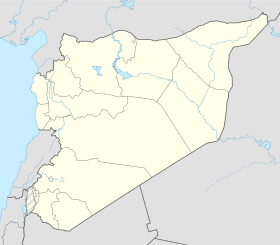
Back عين دارة (موقع أثري) Arabic Ain Dara Catalan Tell Ain Dara German Templo de Ain Dara Spanish Ain Daran temppeli Finnish Ain Dara (site archéologique) French עין דארה (אתר ארכאולוגי) HE Tempio di Ain Dara Italian Girê Endarê Kurdish Ain Dara Dutch
 The remains of the Ain Dara temple before 2018 | |
| Location | Ain Dara village, Afrin, Syria |
|---|---|
| Coordinates | 36°27′33.7″N 36°51′7.5″E / 36.459361°N 36.852083°E |
| Type | Temple |
| Part of | Acropolis |
| Length | 30 m (98 ft) |
| Width | 20 m (66 ft) |
| Area | 600 m2 (6,500 sq ft) |
| History | |
| Material | stone |
| Founded | c. 1300 BC to 740 BC |
| Periods | Iron Age |
| Cultures | Aramean |
| Site notes | |
| Excavation dates | 1980–1985 |
| Condition | ruins |
| Public access | Yes |
The Ain Dara temple is a destroyed Iron Age Syro-Hittite temple noted for its similarities to Solomon's Temple, also known as the "First Temple in Jerusalem", as described in the Hebrew Bible.[1][2][3] It is located near the village of Ain Dara, in Afrin District, Syria.
According to the excavator, Ali Abu Assaf, it existed from 1300 BC until 740 BC and remained almost unchanged during the construction of Solomon's Temple (1000–900 BC) as it had been before[4] so it predates the First Temple.[5] The temples of Emar, Mumbaqat, and Ebla (Temple D) are also comparable, as is the nearby 8th century BCE temple at Tell Tayinat.[3] The surviving sculptures depict lions and sphinxes, which are comparable to the cherubim of the First Temple.
Massive footprints were carved into the floor; whether of giants, humans, or animals is debatable.[4] Also left to speculation is to whom the temple is dedicated. Ain Dara may have been devoted to Inanna, the female Mesopotamian deity of fertility and civilisation,[6] or to the Canaanite version of Ishtar, ʿAṯtart.[7] It also might have been dedicated to the male storm deity Hadad, or it might have been an oracle on a road known as the international coastal highway between the Syrian Desert and Mediterranean Sea.[8]
According to the Assad government, the temple was significantly damaged by Turkish jets during the Turkish military operation in Afrin in late January 2018.[9] Reports indicate that at least 60% percent of the structure was reduced to rubble.[10] The entire front facade of the temple has been destroyed in photos and video released online. The site's emblematic basalt lion was stolen in December 2019 by members of the Hamza Division, which is part of the Syrian National Army.[11]
- ^ King, Philip J.; Stager, Lawrence E. (2001). Life in Biblical Israel. Louisville, Ky: Westminster John Knox Press. p. 334.
- ^ Long, Jesse (January 2002). 1 & 2 Kings. College Press. pp. 110–111. ISBN 978-0-89900-882-0.
- ^ a b Monson, John M. (June 1999). "The Temple of Solomon: Heart of Jerusalem". In Hess, Richard S.; Wenham, Gordon J. (eds.). Zion, city of our God. Wm. B. Eerdmans Publishing. pp. 12–19. ISBN 978-0-8028-4426-2.
{{cite book}}:|work=ignored (help) - ^ a b Monson, John M. "The New 'Ain Dara Temple: Closest Solomonic Parallel" (PDF). michaelsheiser.com. Archived from the original (PDF) on 14 July 2011. Retrieved 12 February 2011.
- ^ Hicks, John Mark (March 2001). 1 & 2 Chronicles. College Press. p. 272. ISBN 978-0-89900-883-7.
- ^ Freedman, David Noel; Myers, Allen C.; Beck, Astrid B. (2000). Eerdmans dictionary of the Bible. Wm. B. Eerdmans Publishing. p. 1265. ISBN 978-0-8028-2400-4.
- ^ Lemaire, Andra(c); Adams, Dr Samuel; Baruch Halpern (2009). Book of Kings: Sources, Composition, Historiography and Reception. BRILL. p. 297. ISBN 978-90-04-17729-1.
- ^ Cite error: The named reference
WaltonBaker2009was invoked but never defined (see the help page). - ^ "Syrian government says Turkish shelling damaged ancient temple". Reuters. Archived from the original on 9 July 2023.
- ^ Turkish bombing damages 3,000-year-old temple in northern Syria
- ^ al-Sabbagh, Hazem (16 December 2019). "American newspaper: Militants affiliated with Turkey stole basalt lion statue from Ain Dara archeological site". Syrian Arab News Agency. Retrieved 23 December 2019.
© MMXXIII Rich X Search. We shall prevail. All rights reserved. Rich X Search
